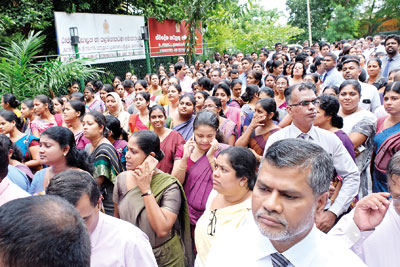News
SLAS seeks huge new allowance to attract top level graduates
The Sri Lanka Administrative Service (SLAS) has called for a new monthly allowance ranging from Rs 50,000-15,000 for all its 2,376 officers in a move that highlights the urgent need for a national policy on salaries.

SLAS officers staged a protest on Thursday protesting against the Cabinet's delay in approving their demand for new allowances. Pic by Amila Gamage
A Cabinet memorandum submitted this week claims that a failure to upgrade SLAS salaries has caused a rapid drop in new graduates of high capacity joining the service; and that, during the past few years, the tendency of male graduates—who, the paper says, seek posts with attractive salaries and allowances—to select the SLAS as a career has declined. Officers in grade III were also quitting for jobs that offer higher remuneration.
The SLAS proposal for a “multitask management and operational allowance”was submitted to the Cabinet by Public Administration Minister Ranjith Maddumma Bandara this week. It is likely to prompt similar demands from other services which are on similar salary scales as SLAS grades. These include the planning, accountancy, scientific, engineering, education administration, and indigenous medicine services.
The paper was not passed this week but Ministers agreed with the justifications for an allowance to “incentivise Sri Lanka Administrative Service in order to attract skilled individuals of high potential”. They said it needed further study and appointed a Cabinet subcommittee to make recommendations within two weeks.
The members of the subcommittee are Science and Technology Minister Sarath Amunugama; Finance Minister Mangala Samaraweera; Home Affairs Minister Vajira Abeywardena; Higher Education Minister Wijayadasa Rajapakshe; and Minister Madduma Bandara.
The SLAS Association (SLASA) protested against the setting up of a subcommittee in lieu of approving the allowance by striking on Thursday. But it suspended action after a discussion with Minister Madduma Bandara. “I assured them not to worry and that I will try my best,” he told the Sunday Times, adding that the subcommittee will meet for the first time this week.
If granted as suggested, 303 special grade SLAS officers will receive an allowance of Rs 50,000 a month each; 750 grade I officers will receive Rs 45,000 each; 76 grade II officers will get Rs 35,000 each and 1,247 grade III officers will be paid between Rs 30,000 and 15,000 each. The Ministry of Finance says this will cost an additional Rs 1 billion a year.
The Cabinet memorandum points out that SLAS officers handle a multitude of tasks including constitutional, developmental, welfare and disaster management. By reason of promotion or transfer, they switch between completely different areas of expertise and must have vast expertise to make challenging decisions. They also provide policy direction, implementation and coordination in a multitude of sectors.
The recommendation of the National Salaries and Cadre Commission to pay these allowances to SLAS officers was also presented to Cabinet. Also attached was a note from President Maithripala Sirisena acknowledging that all SLAS officers performed multiple tasks in the service and in offices. As such, they must be appreciated in manner different to others the permanent cadre. At the same time, they did not have the opportunity to earn private income the way officers in various services did. The President has supported the proposal.
In his observations, Finance Minister Samaraweera has said the Central Bank, State banks, certain corporations, statutory boards and State-owned companies have had their salaries and allowances increased by around 20-25 percent every three years through the revision of collective agreements. In the case of SLAS, however, the basic salary alone is revised once every ten years or so.
Last year, the allowances of university academic staff were increased, placing them above SLAS grades, the Finance Ministry says. The take-home pay of several other sectors are also now higher.
However, the granting of an allowance exclusively to the SLAS could raise protest from other services, public officers warned. At least six island executive parallel services (including SLAS) under the purview of the Public Administration Ministry have the same salary structure and annual increments. The total number of officers is 13,072.
“Other categories of professionals also do the same work,” said one senior official, who did not wish to be named. “There are planning officers, for instance, in divisional secretariats. They handle development and a lot of other tasks including administration. The parallel all island managerial services have not been granted allowances for many years, not just SLAS.”
It was observed that many key economic functions in areas such as health, education, transport, construction, water, irrigation, sewage, electricity, waste management and agriculture are led and performed by non-SLAS officers. They are engineers, doctors, planner, educators, scientists, accountants and others who also coordinate these activities.
Incentivising just SLAS officers is likely to cause unrest and dissatisfaction within Government institutions where a vast majority of employees were typically non-administrative service staff, it has been warned. If the allowance is to be approved, therefore, it was advisable to extend it also to other all-island parallel services.

